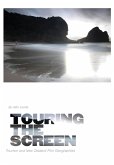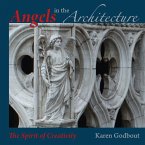Juan Antonio Ramírez
Architecture for the Screen
A Critical Study of Set Design in Hollywood's Golden Age
Juan Antonio Ramírez
Architecture for the Screen
A Critical Study of Set Design in Hollywood's Golden Age
- Broschiertes Buch
- Merkliste
- Auf die Merkliste
- Bewerten Bewerten
- Teilen
- Produkt teilen
- Produkterinnerung
- Produkterinnerung
Explores the many applications of art and architecture appearing in films produced in Hollywood from the very beginning until the fifties. The first chapters deal with the process of design, construction, physical characteristics and immediate functions of a wide variety of architectural sets. The remaining chapters examine the great number of styles shown in those movies and take the reader up to the final triumph of modernist architecture in the aftermath of the Second World War.
Andere Kunden interessierten sich auch für
![Touring the Screen Touring the Screen]() Alfio LeottaTouring the Screen38,99 €
Alfio LeottaTouring the Screen38,99 €![Louise Blanchard Bethune Louise Blanchard Bethune]() Johanna HaysLouise Blanchard Bethune42,99 €
Johanna HaysLouise Blanchard Bethune42,99 €![Angels in the architecture Angels in the architecture]() Karen GodboutAngels in the architecture36,99 €
Karen GodboutAngels in the architecture36,99 €![Historical Comedy on Screen Historical Comedy on Screen]() Historical Comedy on Screen31,99 €
Historical Comedy on Screen31,99 €![Nature's Harmonic Unity Nature's Harmonic Unity]() Samuel ColmanNature's Harmonic Unity23,99 €
Samuel ColmanNature's Harmonic Unity23,99 €![Jonathan Plass Jonathan Plass]() Jonathan S PlassJonathan Plass29,99 €
Jonathan S PlassJonathan Plass29,99 €![Thin Places and Five Clues in Their Architecture Thin Places and Five Clues in Their Architecture]() Page HighfillThin Places and Five Clues in Their Architecture22,99 €
Page HighfillThin Places and Five Clues in Their Architecture22,99 €-
-
-
Explores the many applications of art and architecture appearing in films produced in Hollywood from the very beginning until the fifties. The first chapters deal with the process of design, construction, physical characteristics and immediate functions of a wide variety of architectural sets. The remaining chapters examine the great number of styles shown in those movies and take the reader up to the final triumph of modernist architecture in the aftermath of the Second World War.
Hinweis: Dieser Artikel kann nur an eine deutsche Lieferadresse ausgeliefert werden.
Hinweis: Dieser Artikel kann nur an eine deutsche Lieferadresse ausgeliefert werden.
Produktdetails
- Produktdetails
- Verlag: McFarland
- Seitenzahl: 256
- Erscheinungstermin: 28. März 2012
- Englisch
- Abmessung: 254mm x 178mm x 14mm
- Gewicht: 489g
- ISBN-13: 9780786469307
- ISBN-10: 0786469307
- Artikelnr.: 34444098
- Herstellerkennzeichnung
- Libri GmbH
- Europaallee 1
- 36244 Bad Hersfeld
- gpsr@libri.de
- Verlag: McFarland
- Seitenzahl: 256
- Erscheinungstermin: 28. März 2012
- Englisch
- Abmessung: 254mm x 178mm x 14mm
- Gewicht: 489g
- ISBN-13: 9780786469307
- ISBN-10: 0786469307
- Artikelnr.: 34444098
- Herstellerkennzeichnung
- Libri GmbH
- Europaallee 1
- 36244 Bad Hersfeld
- gpsr@libri.de
Juan Antonio Ramirez, professor of art history at the Universidad Autonoma de Madrid in Spain, is the author of several books on architectural history, modern art, and visual culture.
Table of Contents
Foreword: Architecture in the Movies and Elsewhere in History ( John F.
Moffitt)
Preface to the English Edition: Ten Lessons About Architecture in the
Movies
Preface to the First Edition (1986)
1. General Introduction
Film Architecture and the Crisis of Modernism
From Shooting on Location to Filming in the Studios
The Architecture of Movie Theaters and Architecture in the Movies
Film Architecture vs. Ordinary Architecture
2. Set Design
The First Advances in Art Direction
Architect vs. Director: Joseph Urban
The "Illustrators": Anton Grot and William Cameron Menzies
Stage Designers and Painters: Wilfred Buckland and Ben Carré
Supervising Architects: Hans Dreier, Van Nest Polglase, and Cedric
Gibbons
Other Art Directors
The Design Process
Background Research
Additional Aspects of Design
The Imaginary Client and the Viewing Customer: Scale Models
Working Conditions and the Studio Styles
3. Set Construction
Techniques, Materials, and Architectural Machinery
Tricks of the Trade
The Impact of Sound
4. From Furniture to Artificial Landscapes
Set Dressing and the Accessories Departments
Wardrobes vs. Sets
The Construction of Landscapes
Artificial Oceans and Creative Ship-Building
Heavenly Effects
5. Architecture and Desire: The Character of Film Constructions
Six Distinctive Qualities
Color and Lighting
A Driving Functionalism
6. The Death and Resurrection of Sets
Methods of Destruction: Fire, Burial, Abandonment
The Ruins of Hollywood
Architectural Metempsychosis: The Permanent Sets
Some Statistics
7. Architectural Styles from Antiquity
Mesopotamia and Palestine
Egypt
Greco-Roman Architecture
8. From Medieval to Renaissance Architectural Styles
Castles and Palaces
The Gothic of Terror
Church, Cloister, Street...
Examples from the Renaissance
9. The Provinces of Exoticism
From Legendary Arabia to Contemporary Legend: Moorish Spain
An Archetypal Spain
India
Pan-Slavic Architecture and/or the Jungle
The Far East
Pre-Columbian America
10. From Colonial Baroque to Contemporary Eclecticism
The "Spanish Style" and the Bourgeois Baroque
Did a Cinematic Neo-Classicism Exist?
"American" Architecture, Frontier to Urban
Other (Old World) Countries
11. Modern Architecture Conquers Hollywood
The First Moderns: Urban, Rambova, et al.
Art Deco and Zigzag Geometrization
The Ocean Liner and "Streamline Moderne"
The International Style
Rationalist-Surrealist Architecture in Musicals
12. Epilogue
Some Omnipresent Elements: Staircases, Bathrooms, Bedrooms
Partial Conclusions
Notes
Bibliography
Index
Foreword: Architecture in the Movies and Elsewhere in History ( John F.
Moffitt)
Preface to the English Edition: Ten Lessons About Architecture in the
Movies
Preface to the First Edition (1986)
1. General Introduction
Film Architecture and the Crisis of Modernism
From Shooting on Location to Filming in the Studios
The Architecture of Movie Theaters and Architecture in the Movies
Film Architecture vs. Ordinary Architecture
2. Set Design
The First Advances in Art Direction
Architect vs. Director: Joseph Urban
The "Illustrators": Anton Grot and William Cameron Menzies
Stage Designers and Painters: Wilfred Buckland and Ben Carré
Supervising Architects: Hans Dreier, Van Nest Polglase, and Cedric
Gibbons
Other Art Directors
The Design Process
Background Research
Additional Aspects of Design
The Imaginary Client and the Viewing Customer: Scale Models
Working Conditions and the Studio Styles
3. Set Construction
Techniques, Materials, and Architectural Machinery
Tricks of the Trade
The Impact of Sound
4. From Furniture to Artificial Landscapes
Set Dressing and the Accessories Departments
Wardrobes vs. Sets
The Construction of Landscapes
Artificial Oceans and Creative Ship-Building
Heavenly Effects
5. Architecture and Desire: The Character of Film Constructions
Six Distinctive Qualities
Color and Lighting
A Driving Functionalism
6. The Death and Resurrection of Sets
Methods of Destruction: Fire, Burial, Abandonment
The Ruins of Hollywood
Architectural Metempsychosis: The Permanent Sets
Some Statistics
7. Architectural Styles from Antiquity
Mesopotamia and Palestine
Egypt
Greco-Roman Architecture
8. From Medieval to Renaissance Architectural Styles
Castles and Palaces
The Gothic of Terror
Church, Cloister, Street...
Examples from the Renaissance
9. The Provinces of Exoticism
From Legendary Arabia to Contemporary Legend: Moorish Spain
An Archetypal Spain
India
Pan-Slavic Architecture and/or the Jungle
The Far East
Pre-Columbian America
10. From Colonial Baroque to Contemporary Eclecticism
The "Spanish Style" and the Bourgeois Baroque
Did a Cinematic Neo-Classicism Exist?
"American" Architecture, Frontier to Urban
Other (Old World) Countries
11. Modern Architecture Conquers Hollywood
The First Moderns: Urban, Rambova, et al.
Art Deco and Zigzag Geometrization
The Ocean Liner and "Streamline Moderne"
The International Style
Rationalist-Surrealist Architecture in Musicals
12. Epilogue
Some Omnipresent Elements: Staircases, Bathrooms, Bedrooms
Partial Conclusions
Notes
Bibliography
Index
Table of Contents
Foreword: Architecture in the Movies and Elsewhere in History ( John F.
Moffitt)
Preface to the English Edition: Ten Lessons About Architecture in the
Movies
Preface to the First Edition (1986)
1. General Introduction
Film Architecture and the Crisis of Modernism
From Shooting on Location to Filming in the Studios
The Architecture of Movie Theaters and Architecture in the Movies
Film Architecture vs. Ordinary Architecture
2. Set Design
The First Advances in Art Direction
Architect vs. Director: Joseph Urban
The "Illustrators": Anton Grot and William Cameron Menzies
Stage Designers and Painters: Wilfred Buckland and Ben Carré
Supervising Architects: Hans Dreier, Van Nest Polglase, and Cedric
Gibbons
Other Art Directors
The Design Process
Background Research
Additional Aspects of Design
The Imaginary Client and the Viewing Customer: Scale Models
Working Conditions and the Studio Styles
3. Set Construction
Techniques, Materials, and Architectural Machinery
Tricks of the Trade
The Impact of Sound
4. From Furniture to Artificial Landscapes
Set Dressing and the Accessories Departments
Wardrobes vs. Sets
The Construction of Landscapes
Artificial Oceans and Creative Ship-Building
Heavenly Effects
5. Architecture and Desire: The Character of Film Constructions
Six Distinctive Qualities
Color and Lighting
A Driving Functionalism
6. The Death and Resurrection of Sets
Methods of Destruction: Fire, Burial, Abandonment
The Ruins of Hollywood
Architectural Metempsychosis: The Permanent Sets
Some Statistics
7. Architectural Styles from Antiquity
Mesopotamia and Palestine
Egypt
Greco-Roman Architecture
8. From Medieval to Renaissance Architectural Styles
Castles and Palaces
The Gothic of Terror
Church, Cloister, Street...
Examples from the Renaissance
9. The Provinces of Exoticism
From Legendary Arabia to Contemporary Legend: Moorish Spain
An Archetypal Spain
India
Pan-Slavic Architecture and/or the Jungle
The Far East
Pre-Columbian America
10. From Colonial Baroque to Contemporary Eclecticism
The "Spanish Style" and the Bourgeois Baroque
Did a Cinematic Neo-Classicism Exist?
"American" Architecture, Frontier to Urban
Other (Old World) Countries
11. Modern Architecture Conquers Hollywood
The First Moderns: Urban, Rambova, et al.
Art Deco and Zigzag Geometrization
The Ocean Liner and "Streamline Moderne"
The International Style
Rationalist-Surrealist Architecture in Musicals
12. Epilogue
Some Omnipresent Elements: Staircases, Bathrooms, Bedrooms
Partial Conclusions
Notes
Bibliography
Index
Foreword: Architecture in the Movies and Elsewhere in History ( John F.
Moffitt)
Preface to the English Edition: Ten Lessons About Architecture in the
Movies
Preface to the First Edition (1986)
1. General Introduction
Film Architecture and the Crisis of Modernism
From Shooting on Location to Filming in the Studios
The Architecture of Movie Theaters and Architecture in the Movies
Film Architecture vs. Ordinary Architecture
2. Set Design
The First Advances in Art Direction
Architect vs. Director: Joseph Urban
The "Illustrators": Anton Grot and William Cameron Menzies
Stage Designers and Painters: Wilfred Buckland and Ben Carré
Supervising Architects: Hans Dreier, Van Nest Polglase, and Cedric
Gibbons
Other Art Directors
The Design Process
Background Research
Additional Aspects of Design
The Imaginary Client and the Viewing Customer: Scale Models
Working Conditions and the Studio Styles
3. Set Construction
Techniques, Materials, and Architectural Machinery
Tricks of the Trade
The Impact of Sound
4. From Furniture to Artificial Landscapes
Set Dressing and the Accessories Departments
Wardrobes vs. Sets
The Construction of Landscapes
Artificial Oceans and Creative Ship-Building
Heavenly Effects
5. Architecture and Desire: The Character of Film Constructions
Six Distinctive Qualities
Color and Lighting
A Driving Functionalism
6. The Death and Resurrection of Sets
Methods of Destruction: Fire, Burial, Abandonment
The Ruins of Hollywood
Architectural Metempsychosis: The Permanent Sets
Some Statistics
7. Architectural Styles from Antiquity
Mesopotamia and Palestine
Egypt
Greco-Roman Architecture
8. From Medieval to Renaissance Architectural Styles
Castles and Palaces
The Gothic of Terror
Church, Cloister, Street...
Examples from the Renaissance
9. The Provinces of Exoticism
From Legendary Arabia to Contemporary Legend: Moorish Spain
An Archetypal Spain
India
Pan-Slavic Architecture and/or the Jungle
The Far East
Pre-Columbian America
10. From Colonial Baroque to Contemporary Eclecticism
The "Spanish Style" and the Bourgeois Baroque
Did a Cinematic Neo-Classicism Exist?
"American" Architecture, Frontier to Urban
Other (Old World) Countries
11. Modern Architecture Conquers Hollywood
The First Moderns: Urban, Rambova, et al.
Art Deco and Zigzag Geometrization
The Ocean Liner and "Streamline Moderne"
The International Style
Rationalist-Surrealist Architecture in Musicals
12. Epilogue
Some Omnipresent Elements: Staircases, Bathrooms, Bedrooms
Partial Conclusions
Notes
Bibliography
Index









